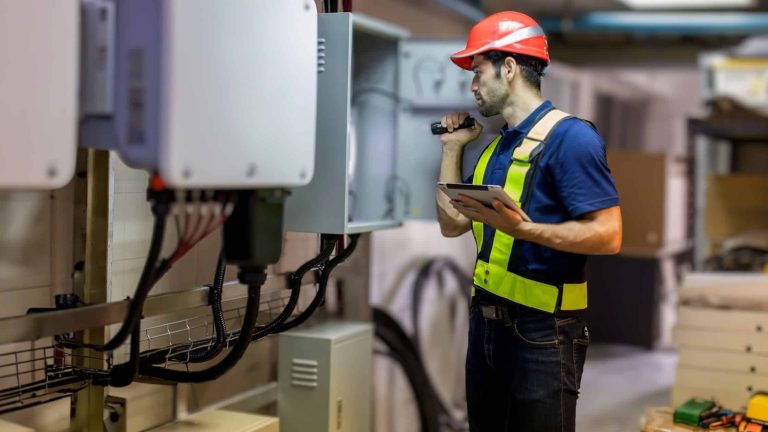Key Takeaways:
Consistent electrical equipment maintenance is essential to ensure operational efficiency and safety in industrial settings. This comprehensive approach involves regular testing, refurbishing to extend equipment life, and strict adherence to safety regulations. By hiring professional maintenance services, companies can enhance their equipment reliability. Furthermore, innovative tools and techniques offer a thorough testing process that preemptively identifies and corrects potential issues.
Table of Contents:
- Introduction
- Regular Testing
- Refurbishing for Longevity
- Safety Regulations and Compliance
- Engaging Professional Maintenance Services
- Tools and Techniques for Comprehensive Testing
- Conclusion
Introduction
In today’s fast-paced industrial landscape, the reliability of electrical equipment is paramount for keeping operations smooth and avoiding costly breakdowns. Electrical systems power machinery and facilities that drive production lines and services are pivotal. Maintenance isn’t merely about fixing problems; it’s a proactive approach that entails anticipation, inspection, and intervention before issues become serious, ensuring systems run optimally over their lifespan. This article explores various facets of electrical maintenance and its critical role in safeguarding operational continuity and safety within organizations.
Regular Testing
Regular testing acts as a safeguard, providing early detection of potential issues within electrical systems before they escalate into more severe problems. It involves a comprehensive evaluation of components using advanced tools and methodologies. Techniques such as thermal imaging allow for the detection of overheating components, while power quality analysis helps identify anomalies in current flow. Electrical equipment testing and refurbishing ensure that every part functions at its best, offering insights into immediate repairs and long-term maintenance strategies. By identifying inefficiencies and vulnerabilities early, testing enhances system longevity and reliability, minimizing downtime and reducing potential catastrophic failures. Visit this site https://divergentalliance.com/electrical-equipment-testing-refurbishing/ for your reference.
Refurbishing for Longevity
Refurbishing is an essential process in the lifecycle management of electrical equipment, standing as a cornerstone for sustainability and efficiency. Unlike simple repairs that fix minor issues, refurbishing involves thoroughly rebuilding or upgrading equipment. This process can modernize older systems, aligning them with current technology standards and performance expectations. It not only extends the life of equipment but also improves its operational efficiency, making it a cost-effective alternative to purchasing new machinery. This approach contributes significantly to sustainability by reducing waste and conserving resources, showcasing a commitment to environmental stewardship.
Safety Regulations and Compliance
Adhering to safety regulations and compliance standards is non-negotiable in electrical equipment maintenance. These regulations are meticulously designed to ensure the safety of workers, prevent equipment malfunctions, and avoid hazardous situations. Compliance demands that businesses stay informed about the latest legislative requirements and incorporate them into their maintenance protocols. It involves regular updates and training to ensure all team members diligently understand and practice safety measures. Complying with these standards protects employees and assets, enhances reputational trust, and avoids legal complications. For more information, the codes and standards maintained by authorities offer comprehensive guidance on maintaining safety and compliance in electrical equipment maintenance.
Engaging Professional Maintenance Services
While internal maintenance teams offer day-to-day support, the role of professional services in electrical maintenance introduces a higher level of expertise and precision. External professionals provide an in-depth understanding of complex electrical systems and advanced diagnostic equipment that can uncover issues not visible to the untrained eye. These experts bring experience and bespoke solutions tailored to specific industry needs. Their intervention often results in improved operational efficiency, cost savings, and access to the latest industry trends and techniques. The decision to hire a professional service often translates into a strategic advantage by ensuring that equipment is maintained at peak performance, thus reducing unexpected failures and extending the operational life of electrical assets.
Additionally, professional maintenance teams adhere to stringent safety protocols, minimizing risks associated with electrical malfunctions. Their proactive approach helps prevent costly downtime by identifying potential failures before they escalate into significant disruptions. With access to specialized tools and technology, these experts can perform precision testing and predictive maintenance, further enhancing system reliability. Businesses also benefit from compliance assurance, as professional services ensure adherence to industry regulations and standards. Outsourcing electrical maintenance allows organizations to focus on core operations while leaving critical infrastructure to experienced specialists.
Tools and Techniques for Comprehensive Testing
Incorporating advanced tools and techniques into maintenance routines is critical for the comprehensive testing of electrical systems. Technological advancements have equipped maintenance teams with capabilities far beyond basic inspection. Tools like circuit testers, thermographic cameras, and power quality analyzers allow detailed insights into the health of systems. These technologies facilitate predictive maintenance by highlighting potential issues before they become significant problems, enabling proactive management. These tools can decrease maintenance costs, improve safety standards, and ensure continuous operations by reducing the uncertainty around equipment performance and maintenance needs. Embracing technology in maintenance strategies is a forward-thinking approach that secures electrical systems’ long-term viability and reliability.
Conclusion
The importance of diligent maintenance of electrical equipment cannot be overstated. It involves an intricate dance of regular testing, refurbishing efforts, compliance with safety standards, and the employment of professional services. Adopting advanced tools and techniques further strengthens maintenance regimes, ensuring that businesses can forego unexpected and costly interruptions. Organizations can significantly improve efficiency, safety, and operational continuity through a comprehensive approach to electrical maintenance. As businesses strive for perfection, integrating robust maintenance strategies becomes essential in pursuing reliability and operational excellence.

